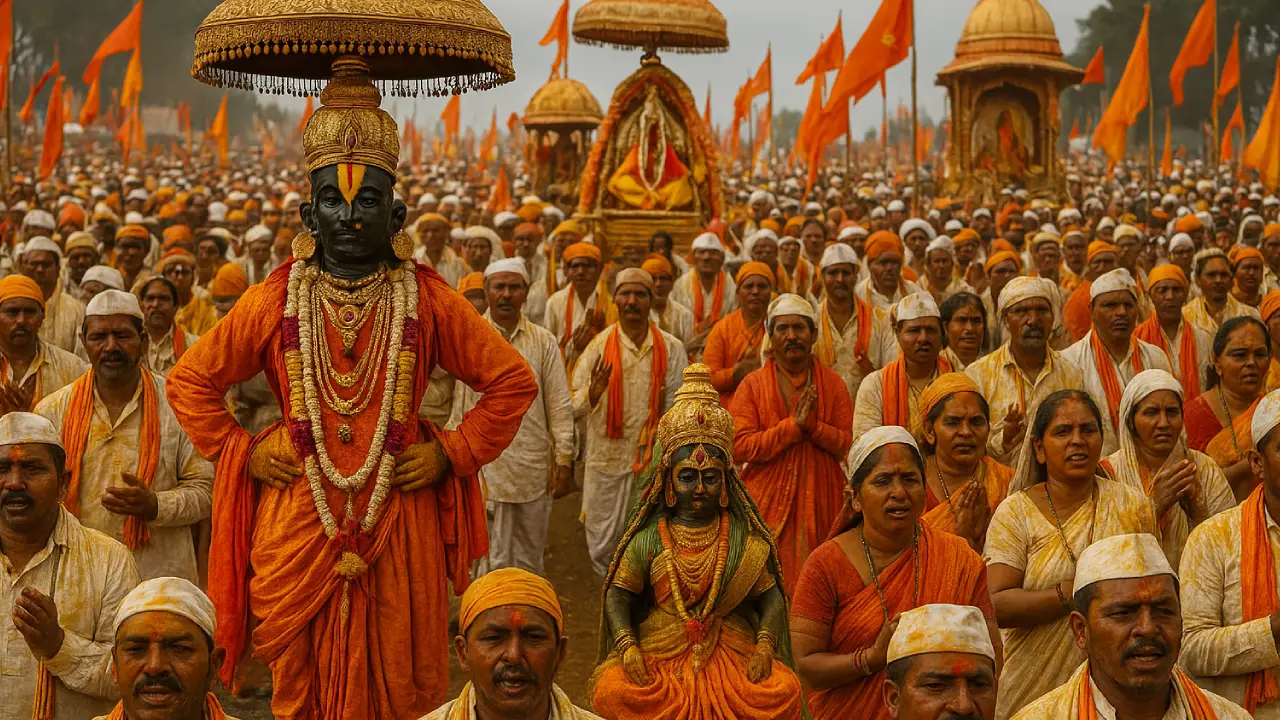The holy month of Ashadha brings a special opportunity for spiritual growth. Among its many sacred days, Ashadhi Ekadashi holds a special place. Celebrated on the eleventh day of the bright fortnight of Ashadha (June-July), this day is dedicated to Lord Vishnu and His incarnation as Vitthal or Vithoba.
Ashadhi Ekadashi is not just about rituals. It is a deeply personal and transformative experience. It invites us to pause, reflect, and reconnect with divinity through devotion, fasting, and self-discipline.
Why Ashadhi Ekadashi Matters
For centuries, saints and devotees have emphasized the spiritual power of Ekadashi. But Ashadhi Ekadashi is extra special. It marks the beginning of the Chaturmas, a four-month period believed to be ideal for spiritual practices.
According to the scriptures, Lord Vishnu enters a meditative state during this period. Devotees believe that pleasing Him on this day can bring immense blessings. For the people of Maharashtra and many other parts of India, this day is a grand spiritual event.
The Pandharpur Wari: A Moving Expression of Devotion
Nothing captures the spirit of Ashadhi Ekadashi like the famous Pandharpur Wari. Lakhs of devotees walk barefoot from across Maharashtra to reach Pandharpur, the abode of Lord Vitthal. This 21-day pilgrimage is filled with bhajans, abhangas, dancing, and singing.
What’s touching is the sheer humility and joy of the warkaris (pilgrims). Many of them come from modest backgrounds. Yet their faith moves mountains—literally and spiritually.
A friend once shared how her 75-year-old grandfather joined the Wari. Despite aching knees, he said, “My pain dissolves when I see Vitthal.” That’s the kind of faith this day inspires.
The Deeper Meaning Behind the Fast
Ashadhi Ekadashi is observed through fasting and prayer. But fasting isn’t just about skipping food. It’s about cleansing the body and mind. It teaches self-control and helps turn focus inward.
Many people fast on this day by consuming only fruits and water. Some observe Nirjala fast, where even water is avoided. The goal is not to suffer, but to purify. Fasting helps quiet the senses so the mind can focus on devotion.
If you’ve never fasted before, start simple. Have a fruit-only day and dedicate some time to chanting or reading scriptures. The benefits go beyond the spiritual—it can even help reset your eating habits and improve focus.
Connecting with Lord Vitthal: The Bhakti Path
Ashadhi Ekadashi is devoted to Vitthal, the form of Krishna worshipped in Maharashtra. His devotees believe He stands patiently, waiting for their love.
The story of Sant Tukaram, a saint-poet from Maharashtra, shows how simple faith can touch the divine. He wasn’t rich or educated. But his poems, called abhangas, expressed pure love for Vitthal. Even today, people sing his abhangas during the Wari and in temples across the country.
His life reminds us that the divine doesn’t care for status. A heart full of love and surrender is all that’s needed.
Daily Practices You Can Start on Ashadhi Ekadashi
You don’t need to be in Pandharpur to celebrate. Ashadhi Ekadashi is also about small, heartfelt practices. Here’s how you can make this day meaningful:
- Wake up early and take a holy bath.
- Chant Vishnu mantras, such as “Om Namo Bhagavate Vasudevaya.”
- Read the Bhagavad Gita or Vishnu Sahasranama.
- Avoid harsh speech, gossip, or anger for the day.
- Meditate for 15-30 minutes, focusing on peace and surrender.
- Offer tulsi leaves to a picture or idol of Lord Vishnu.
- Light a lamp and offer simple prasad, such as fruits or sabudana khichdi.
- Even a small offering made with love counts. The divine looks for sincerity, not show.
How This Day Can Transform Your Life
People often say, “I don’t have time for spirituality.” But days like Ashadhi Ekadashi help break that pattern. Even taking out a single day for inner work can change your energy.
Here’s what a simple celebration of Ashadhi Ekadashi can do:
Brings mental clarity and emotional stability.
Helps reduce restlessness and anxiety.
Strengthens willpower and discipline.
Deepens your connection to the divine.
These are not just beliefs. Many devotees who observe this day regularly share how they feel lighter, more peaceful, and more centered.
A Story That Stays with Me
A few years ago, I met a man at a local temple during Ashadhi Ekadashi. He was quietly offering tulsi leaves to the deity, chanting softly. I later learned that he was going through a major financial crisis.
When I asked how he could stay so calm, he smiled and said, “Vitthal knows. This too shall pass.”
He wasn’t denying his problems. But his faith gave him strength. That’s what Ashadhi Ekadashi offers—a deep inner anchor during life’s storms.
Children and Youth Can Celebrate Too
Ashadhi Ekadashi isn’t only for the elderly. It’s a great way to introduce children and teens to spiritual values. You can:
Encourage them to make a drawing of Vitthal-Rukmini.
Ask them to learn a simple bhajan and sing it.
Share stories of Sant Tukaram or Sant Dnyaneshwar.
Involve them in making simple prasad.
Children absorb more through experience than lectures. Celebrating together can help build a lasting bond with dharma.
Final Thoughts: Let This Day Be Your Turning Point
Ashadhi Ekadashi comes once a year. But the spiritual benefits it offers can last forever. Even if you’re busy, give this day a chance.
You don’t need to do everything. Start small. Skip one meal. Say one prayer. Light one lamp. But do it with love.
As you walk your path—stumbling, rising, learning—know that Vitthal waits. Always. With open arms and endless patience.
Have You Celebrated Ashadhi Ekadashi Before?
How do you connect with Lord Vitthal? Have you ever walked the Wari or observed a fast on this day?
Share your experiences or stories in the comments. Let’s inspire each other on this beautiful path.

